Over the past few years it’s arguable the line between indie games and non-indie games has become blurred. With digital $10-$20 titles now more accepted than ever, studios can take risks and try smaller creative projects. For Insomniac, that project is Song of the Deep.
A sidescrolling Metroidvania game, Song of the Deep places players in the shoes of a young girl, Merryn, who has grown up listening to the wondrous stories her father tells about the ancient kingdoms at the bottom of the ocean. When her father fails to return from a fishing trip though, she builds a submarine and dives beneath the waves to rescue him. From there, Merryn finds herself in a world of perilous caves, underwater forests, grand ruins, and sea monsters.
Heart-felt and beautiful, Song of the Deep is essentially a picture book full of clever puzzles. It has an interesting and diverse map to explore, complete with plenty of secrets stashed away in its depths. Relying on these aspects, the game excels. It’s only when Song of the Deep turns to focus more on combat that it then struggles.
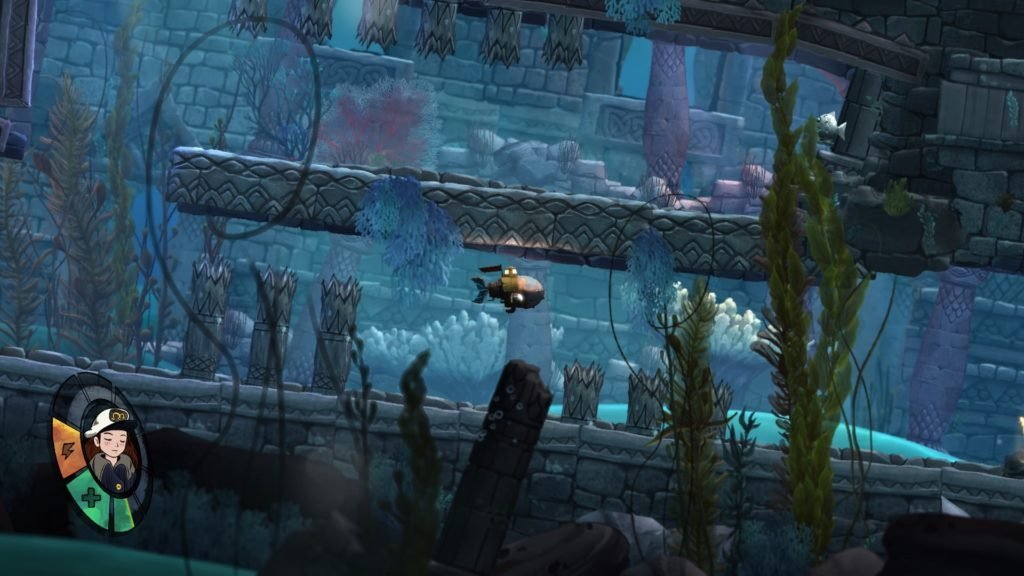
Insomniac’s latest tells a simple story. While searching for her father, Merryn learns about and uncovers the history behind two ancient races that once lived in the ocean: the Merrows (mermaids) and the technologically advanced Fomori. The entire game is doled out through excellent narration, evoking a child-like sense of magic as the plot unfolds like someone is reading you a children’s book.
In terms of both tone and presentation, it’s easy to draw comparisons to Ubisoft’s iambic-pentameter-uttering RPG, Child of Light. For better or worse (depending on how you felt about Child of Light), Song of the Deep never pushes quite that far, and is instead satisfied telling a more tradition children’s story. Either way, combining the narration with the vibrant, beautiful art of the environment, it’s clear from the moment the game starts just how much heart and devotion Insomniac poured into it. And for the most part, it’s fun to play.
Like any Metroidvania, the gameplay largely involves exploring areas, finding new weapons and tools, and using those to access new areas. The first thing Merryn finds is a claw she attaches to her submarine and can use to pick up objects, break wooden barriers, and even hit enemies. And right away one of Song of the Deep’s most unique gameplay aspects rears its peculiar head. Aiming and movement are one in the same.
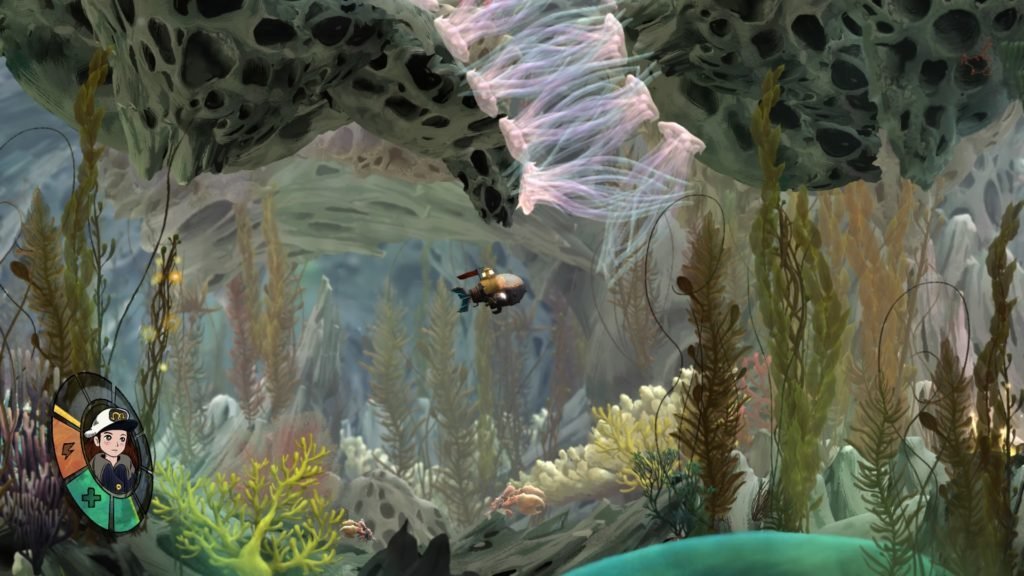
Be it the claw or the different torpedoes you eventually find in your travels, aiming your weapons is controlled with the movement of your submarine. This doesn’t mean they are directly connected to the front of the sub however. Merryn’s submarine takes time to turn around. Momentum can carry it through the water, even after you have pulled the analog stick in a different direction. The direction you pull the stick though is the direction your weapons fire.
While not being a normal twin-stick shooter or simply having the weapons matched one-to-one with the orientation of the ship feels unnatural, eventually the in-between path Song of the Deep takes does grow on you. I’ll admit the first few hours were frustrating as my mind struggled to wrap itself around the system. But soon, the quick flicks of the analog stick as you attack, while allowing momentum to carry you, followed by a second of boost to get back up to speed, become a basic part of the game’s tempo.
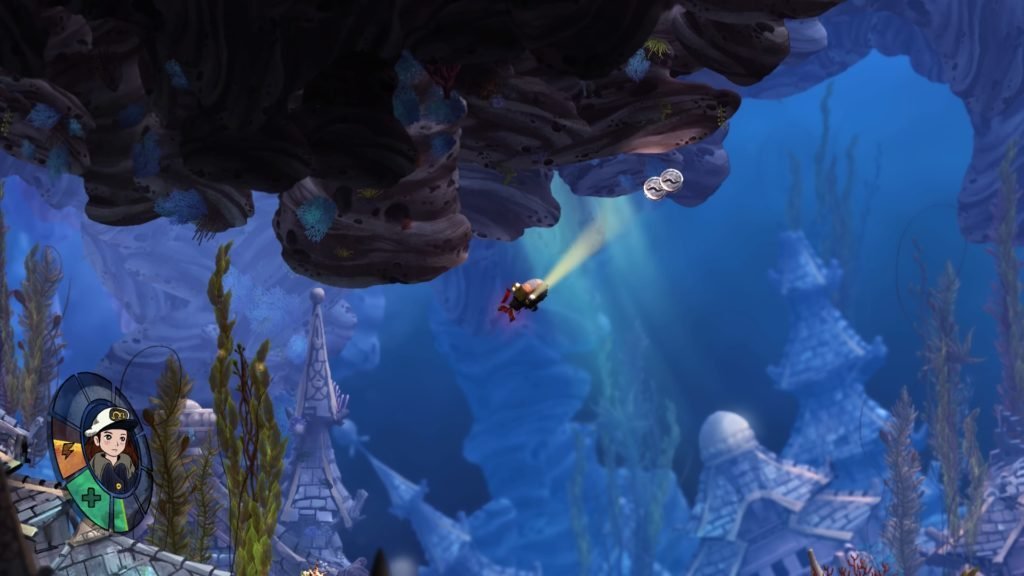
It took me roughly eight hours to roll the credits on Song of the Deep. And throughout that time the new items and unlocks never stop changing how the game plays in surprising ways. While the claw starts the puzzles off simple with the likes of finding the head of a statue and placing it back where it belongs, soon the puzzles, and the environment as a whole, become delightfully more complex. Each newly unlocked ability plays a role in exploration, puzzles, and combat, but not always in the form that you would expect.
Not far into the game, Merryn comes across an old diving suit for instance. With the new ability to leave the sub and swim around, not only can she go through openings the sub is too large for, she can also manually interact with different puzzle elements in a way you couldn’t normally. Likewise, even the smallest enemy encounter becomes far more treacherous as soon as you don’t have your submarine and its weapons to protect you.
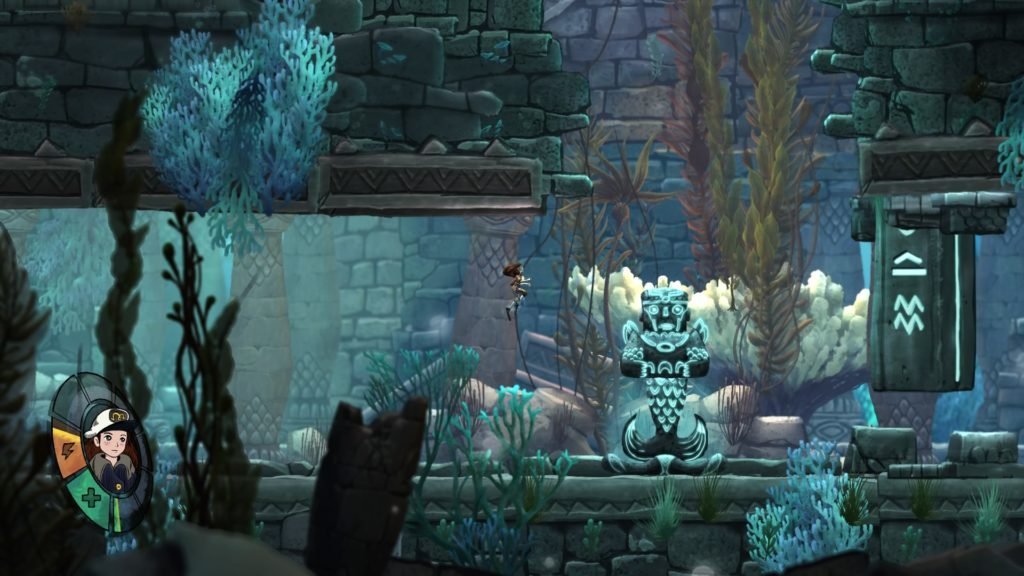
Overall, there are a handful of basic abilities unlocked through the course of playing the game’s story. Each of these then has multiple upgrades that you can purchase from hermit crabs throughout the map. The upgrades range from the simple, like increasing the amount of time you can use your boost turbine or how much health you regain from health pick-ups, to the more interesting, like adding an electrical charge to your claw or giving you the ability to turn your torpedoes into traps.
Killing enemies, smashing pots, and exploring the map all grant you the coins used to buy upgrades. For a larger payday, treasures are hidden away behind puzzles at every turn. Often in the case of explosives for instance, it’s obvious you have to figure out how to get them from point A to point B, all in the hopes of blasting open a door to progress. But if you figure out how to take the explosives another direction, you can find and open a different door, unlocking a treasure.
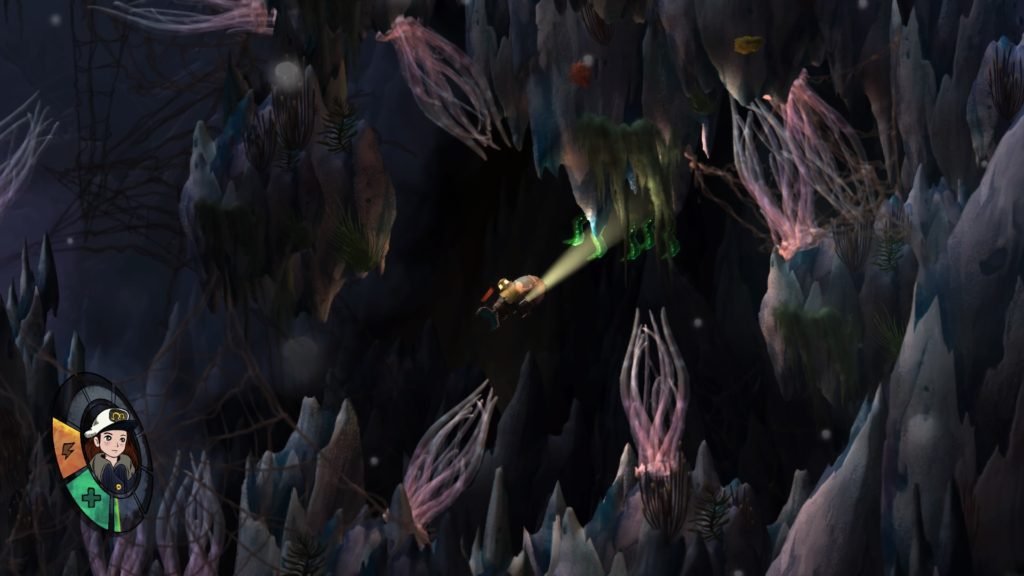
More than any of the basic abilities however, it is the items that change up gameplay the most. Each hidden behind puzzles of their own, most items increase your health or energy, but some dramatically change and add new functionality to your core abilities. Song of the Deep makes it feel rewarding to take that extra time, scour every corner, and push though that puzzle that’s giving you trouble.
In all, Insomniac offers a fun premise, a beautiful world, and plenty of reason to explore that world. Where the game begins to struggle is in its growing reliance on combat throughout its latter half. First off, there just aren’t that many different types of enemies. There is a handful that are unique, specifically jellyfish, anglerfish, sea urchins, crabs, and the mechanical Fomori sentinels. However, each new type of enemy after that is simply a more powerful version of the ones you have already fought, their general attacks and behavior changing very little.
This lack of diversity in the enemies is particularly felt in terms of the process required to beat them. Once you have figured out the combat mechanic for a specific type of enemy, it never really changes. Where challenge could have been added through making certain enemies react differently to different weapons for instance, Song of the Deep unfortunately takes two much less desirable roads. It both throws an increasing number of the same enemies at you and makes the game harder to control.
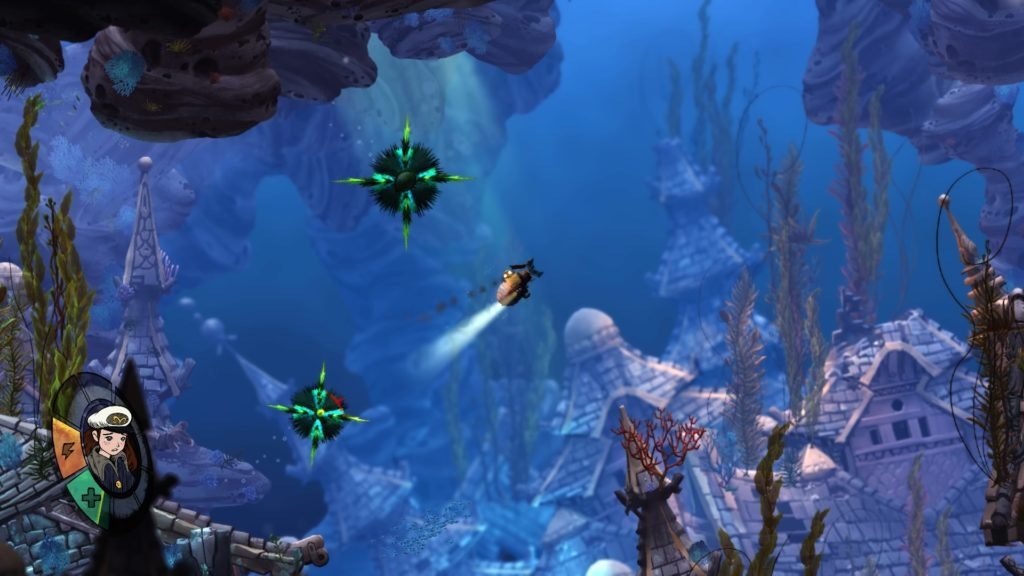
Throughout the end of the game, it becomes common to simply enter a room and have all the doors close, locking you in as you fight wave after wave of enemies. Survive until the end and the doors re-open. While tense and surprising the first time, Song of the Deep uses the same device often that by the end it simply becomes tedium. Sadly the ‘locked in a room for waves of enemies’ mechanic is even the set up for the final boss fight.
Where matters get worse, however, is when changes in current accompany the waves of enemies. Much of Song of the Deep is about both fighting against and using the natural currents of the water. For the game’s exploration and puzzles, it serves as a reasonable obstacle. The problems arise when the game introduces objects into the environment that create currents, or certain rooms built to have natural currents, all to make it much harder to control your submarine during combat.
While nothing would be empirically wrong with the mechanic being used in one or two fights to liven things up, relying on it as a primary mechanic throughout the game leads to unneeded frustration. More often then not, deaths left me feeling cheated, the game having robbed me of control in that last crucial moment. Zipping between enemy projectiles is hard enough considering the submarine isn’t very nimble to begin with. But doing so while trying to fight against currents pushing and pulling you in multiple directions simply isn’t all that much fun.
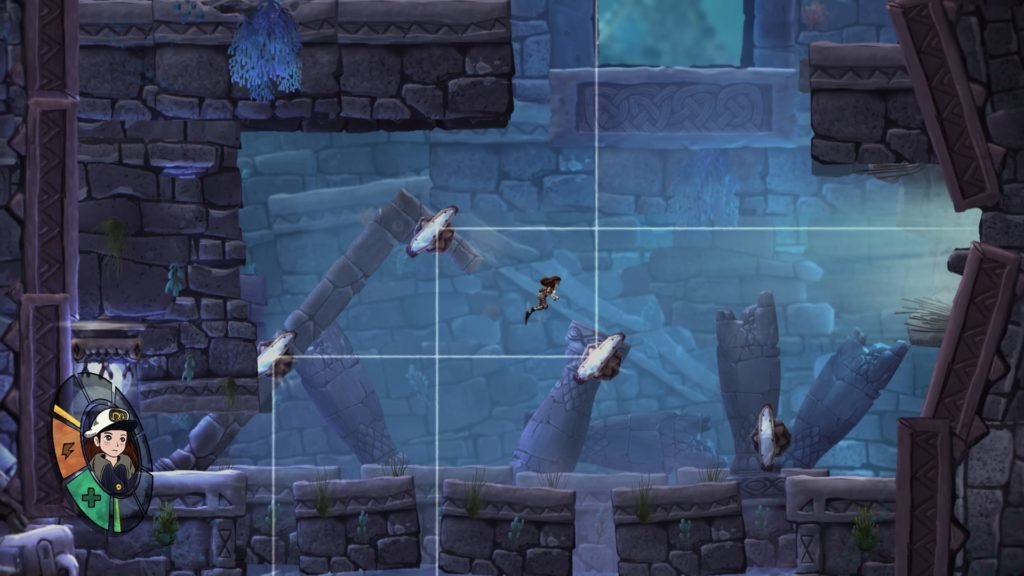
Beyond these issues though, there is a delightful adventure to be found in Song of the Deep. Aside from the occasional stuttering when (I assume) the game is loading a new area and the brief pause every time you pass over a save point, the game world is stunning and a joy to explore. It’s neither the deepest, nor most original Metroidvania out there, but it also doesn’t need to be.
Despite the problems with the combat, Song of the Deep is ultimately still charming and pleasant. There is enough depth with the items and puzzles to interest long time gamers, while the title as a whole is put together in a way that makes it great to sit down and maybe even play with your kids.

